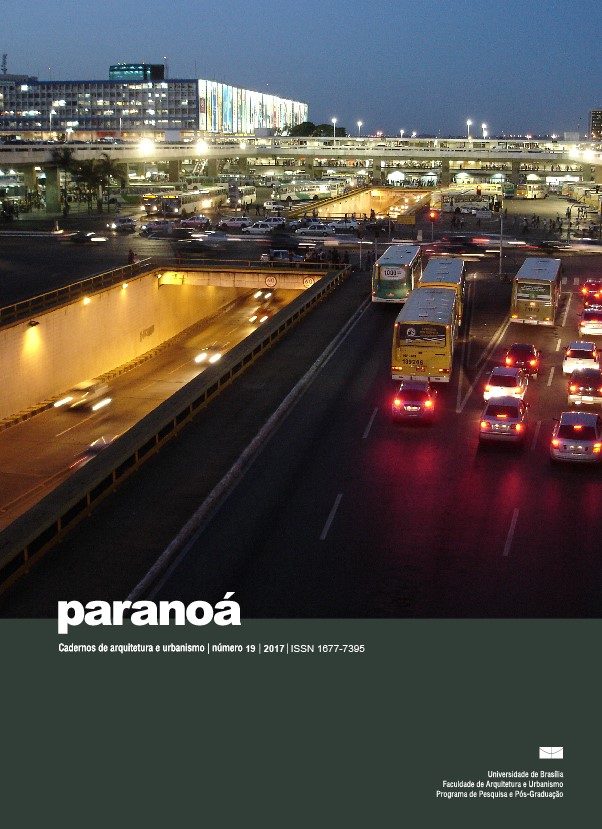A dimensão humana da sustentabilidade
DOI:
https://doi.org/10.18830/issn.1679-0944.n19.2017.08Keywords:
Sustainable architecture, Human dimension, Human space, Sustainability, WellbeingAbstract
Progress at any cost has neglected the human being, causing damage to physical, emotional and environmental health. Sustainable architecture, seeking to avoid climate change, is the new trend that pushes architects, engineers and builders who pay attention to the phenomenon of global warming and the economic benefits brought by energy certificates. However, these contemporary practices rely on the same misconception as the second half of the nineteenth century, when the cities were designed for machines ignoring the human scale. If architecture is capable of producing delight, amazement and relevance; as well as being able to shape the culture, frame the welfare, and contribute to health and happiness, it plays a big role in the most ordinary of routines. However, sustainability solutions have been limited analytically to the adoption of new technologies that can't provide well-being by themselves, in many cases not even for fresh air. Sociological, psychological and holistic reflection is necessary in order to reach sustainability on the planet and full-fill human needs. The city of the future must seduce and provide delight. Focusing ahead on resource scarcity, sustainable architecture should target the psychological misery in which we are currently immersed. We must reconcile Man with nature and, in turn, Architecture and humanity.
Downloads
References
GONÇALVES SOUZA, R. Mundo Educação. Mundo Educação, 23 Abril 2015. Disponivel em: .
CANTO, R. Qual é o habitat do ser humano? Carta Capital, 2013. Disponivel em: . Acesso em: 23 Outubro 2015.
KWINTER, S. Notas sobre a terceira ecologia. In: DESIGN, H. U. S. O. Urbanismo ecológico. São Paulo: Gustavo Gilli, 2014. p. 94-105.
WALDHEIM, C. Obra fraca: "a metrópole fraca" de Andrea Branzi e o potencial de projeto do "urbanismo ecológico". In: DESIGN, H. U. S. O. Urbanismo Ecológico. São Paulo: Gustavo Gilli, 2014. p. 114-120.
BERMUDEZ, J. Simplicidade, Ciência, Espiritualidade, Situação: Quatro maneiras de a Arquitetura enxergar o futuro. CadernosProArq, n. 22, p. 15-27, 2014.
ALPHANDÉRY, P.; BITOUN, P.; DUPONT, Y. O Equívoco Ecológico. São Paulo: Brasiliense, 2000.
NAÇÕES UNIDAS NO BRASIL. Nações Unidas no Brasil. Nações Unidas no Brasil, 26 Outubro 2015. Disponivel em: .
SPIRN, A. W. The Granite Garden. Estados Unidos: Basic Books, 1984.
BECK, U. Desigualdade social e mudanças climáticas. In: DESIGN, H. U. S. O. Urbanismo Ecológico. São Paulo: Gustavo Gilli, 2014. p. 106-110.
JOHNSON, K. The Guardian, 11 Junho 2013. Disponivel em: . Acesso em: 26 Outubro 2015.
Å AFRÁNKOVÁ, J. Sociological and Psychological Aspects of Architecture and Urban Space. OL PAN, p. 15-22, 2006.
CEPP. Centro de Estudos do Pensamento Político. CEPP, 27 Outubro 2015. Disponivel em: .
SUÁREZ, X. L. M. Prólogo. In: GAUZIN-MÜLLER, D. Arquitectura ecológica: 29 ejemplos europeos. Barcelona: Gustavo Gilli, 2002. p. 8.
MUXÍ, Z.; MONTANER, J. M. Arquitectura y Política: Ensayos para mundos alternativos. Barcelona: Gustavo Gilli, 2011.
LEFEBVRE, H. A Revolução Urbana. Belo Horizonte: Editora UFMG, 2002.
LEFEBVRE, H. O direito à cidade. São Paulo: Editora Centauro, 2008.
WORLD HEALTH ORGANIZATION. World Health Organization. World Health Organization, 27 Outubro 2015. Disponivel em: .
GAUZIN-MÜLLER, D. Arquitectura ecológica: 29 ejemplos europeos. Barcelona: Gustavo Gilli, 2002.
SCHULZ, N. Genius Loci. Towards a Phenomenology of Architecture. Nova York: Academy Editions, 1980.
Å AFRÁNKOVÁ, J. Urban Revitalization And Possibilities Of Public Participation. OL PAN, p. 95-103, 2005.
BRANZI, A. Para um pós-ambientalismo: sete sugestões para uma "Nova Carta de Atenas". In: DESIGN, H. U. S. O. Urbanismo Ecológico. São Paulo: Gustavo Gilli, 2014. p. 110-113.
Å LHÁNKOVÁ, V. Indicators of Sustainable Development for Municipalities. Prague: Civitas per Populi, 2011.
THE GOVERNMENT OFFICE FOR SCIENCE. Foresight Mental Capital and Wellbeing Project. London: [s.n.], 2008. Disponivel em: . Acesso em: 2015 Outubro 26.
CABE. The Value of Public Space. London: CABE, 2004. Disponivel em: . Acesso em: 26 Outubro 2015.
CABE. Sustainable places for health and well-being. London: Comission for Architecture and Built Environment, 2009.
DECRETO No 99.710, DE 21 DE NOVEMBRO DE 1990. Disponivel em: . Acesso em: 26 Outubro 2015.
STEEMERS, K. Architecture for well-being and health. D&A Magazine, p. 1-22, 2015. Disponivel em: . Acesso em: 26 Outubro 2015.
MEHTA, R.; ZHU, R. Blue or Red? Exploring the Effect of Color on Cognitive Task Performances. SCIENCE, 27 Fevereiro 2009. 1226-1229.
MARQUEZ, G. G. Cien Años de Soledad. Argentina: Debolsillo, 2008.
GALLO, M. El tiempo en "Cien Años de Soledad" de Gabriel García Marquez. Actas IV. [S.l.]: [s.n.]. 1971. p. 561-571.
KULIN, K. Mito y realidad en "Cien años de soledad". AIH. [S.l.]: [s.n.]. 1971. p. 91-100.
GOLDBERGER, P. A relevância da Arquitetura. São Paulo : BEÎ Comunicação, 2011.
URIARTE, U. M. A Rebelião do Vivido. Henri Lefebvre no Centro de Salvador. III Seminário Internacional Urbicentros. Salvador: [s.n.]. 2012.
CIAM - CONGRESSO INTERNACIONAL DE ARQUITETURA MODERNA. A Carta de Atenas. IPHAN, 1933. Disponivel em: . Acesso em: 2015.
LEVI-STRAUSS, C. Tristes Trópicos. São Paulo: Companhia das Letras, 1996.
Downloads
How to Cite
Issue
Section
License
Autores que publicam nesta revista concordam com os seguintes termos:
- Autores mantém os direitos autorais e concedem à revista o direito de primeira publicação, com o trabalho simultaneamente licenciado sob a Licença Creative Commons Attribution que permite o compartilhamento do trabalho com reconhecimento da autoria e publicação inicial nesta revista. http://creativecommons.org/licenses/by/4.0
- Autores têm autorização para assumir contratos adicionais separadamente, para distribuição não-exclusiva da versão do trabalho publicada nesta revista (ex.: publicar em repositório institucional ou como capítulo de livro), com reconhecimento de autoria e publicação inicial nesta revista.
- Autores têm permissão e são estimulados a publicar e distribuir seu trabalho online (ex.: em repositórios institucionais ou na sua página pessoal) a qualquer ponto antes ou durante o processo editorial, já que isso pode gerar alterações produtivas, bem como aumentar o impacto e a citação do trabalho publicado (Veja O Efeito do Acesso Livre).















